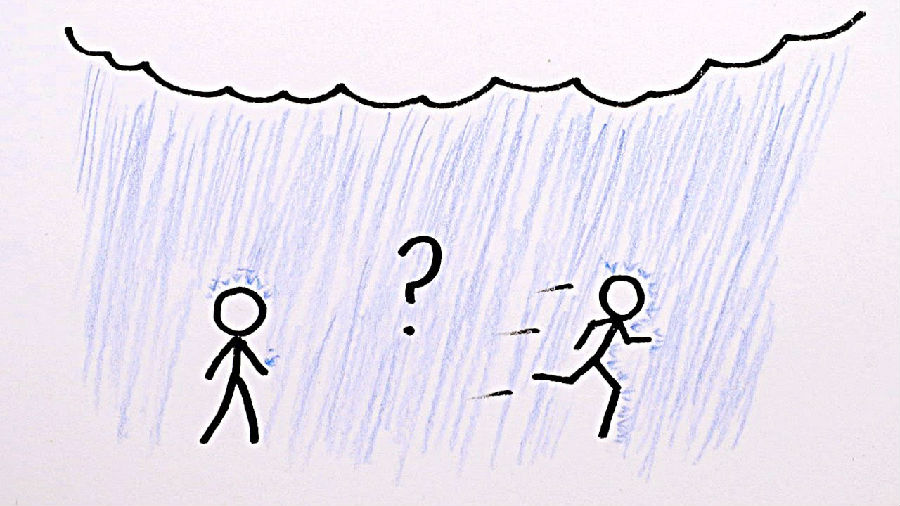On those cold, rainy days when you forget your rain jacket or umbrella and you want to stay as dry as possible…
在那些寒冷的雨天里,你忘记带雨衣或雨伞,还想要尽可能地不被淋湿……
should you walk and spend more time in the rain? Or should you run, which means you'll be smashing into more raindrops from the side?
你是应该在雨中走路呢还是跑步呢(这意味着你将撞上更多的雨滴)?
Assuming you haven't been fully soaked yet and you aren't jumping into puddles, the answer is simple.
假设你还没有完全湿透,也没有跳进水坑里,答案很简单。
As you move out of the way of one falling raindrop, you move into the way of another.
当你从一滴雨下逃脱时,你又跑到了另一滴下面。
So the amount of rain hitting the top of you is constant, regardless of how fast you're going.
所以不管你跑的有多快,雨水打在你身上的量是恒定的。
To see this, you can picture that the raindrops themselves are stationary and you (and the earth beneath you) are moving upwards through the rain!
你可以想象一下,雨滴本身是静止的,你(还有脚下的地面)向上朝着雨移动!

And since the volume of a parallelepiped (that's a 3D parallelogram) doesn't depend at all on its slant,
由于平行六面体(即立体的平行四边形)的体积并不取决于它倾斜的角度,
then no matter how fast you're moving horizontally the same amount of rain will land on top of you each second.
所以不管在水平方向上跑得多快,每秒钟落在你头顶的雨量是一样的。
Now, if you're not moving, the rain from the top is all you'll get.
如果你不动,那么你就只能头顶淋雨。
But if you ARE moving, you'll also run into raindrops from the side and you'll get wetter.
但如果你移动了,你也就撞上了迎面而来的雨,就会被淋得更湿。
So in any given second, you stay driest by standing still, and the faster you move the wetter you become.
所以在每一秒内,你只有站着静止不动才能少淋雨,你跑的越快,淋得越湿。
But if you're trying to get from point A to point B, then standing still won't do you much good.
但如果你想从A点到达B点,那么静立对你就没什么用了。
And en route from point A to point B, the total amount of rain you run into from the side has nothing to do with how fast you're going -
从A点到B的的途中,迎面而来的雨水总量和你奔跑的速度无关—
just like how a snowplow will plow the same amount of snow from a stretch of road regardless of the exact speed it drives.
就像是扫雪机不管开得多快,在同一路线上扫除的雪都是总量的一样。
In the case of running through the rain, you can figure that out using parallelepipeds again.
在雨中穿梭时,你同样可以使用平行六面体来计算。
So over a given period of time, the same amount of rain will hit you from the top, regardless of how fast you're going.
所以在一定时间内,不管你跑的有多快,你头顶上淋的雨量是一样的。
And over a given distance, you'll hit the same amount of rain from the side - again, regardless of how fast you're going.
在一定距离内,不管你跑的有多快,你迎面撞上的雨量是一种的。
So your total wetness is equal to the wetness per second for rain from the top times the amount of time you spend in the rain,
所以你淋雨的总量等于头顶上每秒淋的雨乘以你在雨中待的时间
plus the wetness per meter for rain from the side times the number of meters you travel.
加上每米你被迎面淋的雨乘以你所跑过的路程。
So to stay driest getting from one point to another, you should try to minimize the amount of water falling onto you from above.
所以,为了使自己从一处到另一处时尽可能少淋雨,你应当尽量减少头顶的淋雨量。
And quite simply, that means getting out of the rain as fast as possible.


